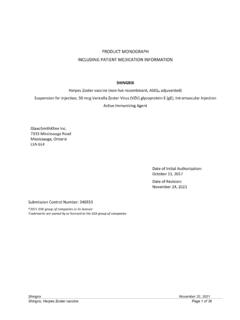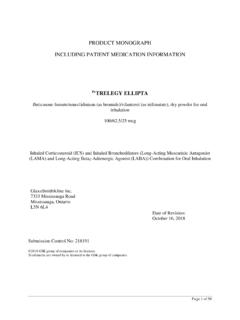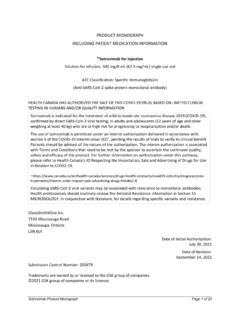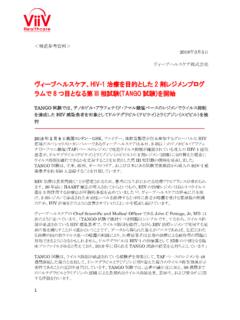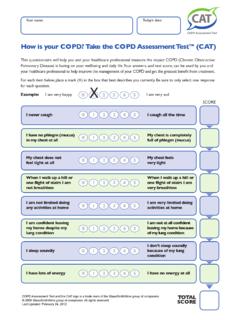Transcription of FLULAVAL TETRA (2018-2019) - GSK.ca
1 FLULAVAL TETRA (2018-2019) glaxosmithkline Approved: April 13, 2018 Page 1 of 25 product MONOGRAPH FLULAVAL TETRA (2018-2019) Quadrivalent Influenza Vaccine (Split Virion, Inactivated) Suspension for Injection ATC Code: J07BB02 Manufactured by: ID Biomedical Corporation of Quebec Quebec, Quebec, Canada Distributed by: glaxosmithkline Inc. 7333 Mississauga Road Mississauga, Ontario L5N 6L4 Date of Revision: 5 April 2018 Date of Approval: April 13, 2018 Control No.: 215287 2018 GSK group of companies or its licensor. Trademarks are owned by or licensed to the GSK group of companies. FLULAVAL TETRA (2018-2019) glaxosmithkline Approved: April 13, 2018 Page 2 of 25 Table of Contents PART I: HEALTH PROFESSIONAL INFORMATION .. 3 SUMMARY product INFORMATION.
2 3 3 INDICATIONS AND CLINICAL USE .. 3 CONTRAINDICATIONS .. 4 WARNINGS AND PRECAUTIONS .. 4 ADVERSE REACTIONS .. 6 DRUG INTERACTIONS .. 14 DOSAGE AND ADMINISTRATION .. 14 OVERDOSAGE .. 15 ACTION AND CLINICAL PHARMACOLOGY .. 15 STORAGE AND STABILITY .. 16 SPECIAL HANDLING INSTRUCTIONS .. 16 DOSAGE FORMS, COMPOSITION AND PACKAGING .. 16 PART II: SCIENTIFIC INFORMATION .. 18 PHARMACEUTICAL INFORMATION .. 18 CLINICAL TRIALS .. 18 TOXICOLOGY .. 23 REFERENCES .. 23 PART III: CONSUMER 24 FLULAVAL TETRA (2018-2019) glaxosmithkline Approved: April 13, 2018 Page 3 of 25 FLULAVAL TETRA (2018-2019) Quadrivalent influenza vaccine (split virion, inactivated) PART I: HEALTH PROFESSIONAL INFORMATION SUMMARY product INFORMATION Route of Administration Dosage Form / Strength Clinically Relevant Nonmedicinal Ingredients Intramuscular Suspension for Injection Each mL dose contains 15 g of influenza virus haemagglutinin/strain for each strain listed below (see Description) Egg proteins, sodium deoxycholate, ethanol, formaldehyde, sucrose, -tocopheryl hydrogen succinate, polysorbate 80, thimerosal* For a complete listing see Dosage Forms, Composition and Packaging section.
3 * multidose presentation DESCRIPTION FLULAVAL TETRA is a quadrivalent split-virion, inactivated influenza vaccine prepared from virus grown in the allantoic cavity of embryonated hens eggs. The virus is inactivated with ultraviolet light treatment followed by formaldehyde treatment, purified by centrifugation and disrupted with sodium deoxycholate. This vaccine complies with the World Health Organization (WHO) recommendation (Northern Hemisphere) for the 2018-2019 season. Each dose of vaccine contains 15 micrograms haemagglutinin of each of the following four influenza virus strains: 15 g HA - A/Michigan/45/2015 (H1N1)pdm09-like virus 15 g HA - A/Singapore/INFIMH-16-0019/2016 (H3N2)-like virus 15 g HA - B/Phuket/3073/2013-like virus from B/Yamagata lineage 15 g HA - B/Colorado/06/2017-like virus from B/Victoria lineage INDICATIONS AND CLINICAL USE FLULAVAL TETRA is a quadrivalent vaccine indicated for active immunization of adults and children from 6 months of age for the prevention of influenza disease caused by influenza virus types A and B contained in the vaccine.
4 FLULAVAL TETRA (2018-2019) glaxosmithkline Approved: April 13, 2018 Page 4 of 25 The National Advisory Committee on Immunization (NACI) provides additional guidance on the use of the influenza vaccine in Canada. Please refer to published Statement on Seasonal Influenza Vaccine for the current season. CONTRAINDICATIONS FLULAVAL TETRA should not be administered to subjects with known hypersensitivity to egg proteins or after previous administration of any influenza vaccine produced in eggs or to any component of the vaccine. WARNINGS AND PRECAUTIONS FLULAVAL TETRA should under no circumstances be administered intravascularly. General It is good clinical practice to precede vaccination by a review of the medical history (especially with regard to previous vaccination and the possible occurrence of undesirable events) and a clinical examination.
5 Syncope (fainting) can occur following, or even before, any vaccination as a psychogenic response to the needle injection. It is important that procedures are in place to avoid injury from faints. As with any vaccine, a protective immune response may not be elicited in all vaccinees. FLULAVAL TETRA is not effective against all possible strains of influenza virus. FLULAVAL TETRA is intended to provide protection against those strains of virus from which the vaccine is prepared and to closely related strains. Febrile or acute disease As with other vaccines, vaccination with FLULAVAL TETRA should be postponed in subjects suffering from an acute severe febrile illness. The presence of a minor infection, such as a cold, should not result in the deferral of vaccination.
6 Serious Warnings and Precautions As with all injectable vaccines, appropriate medical treatment and supervision should always be readily available in case of an anaphylactic event following the administration of the vaccine. FLULAVAL TETRA (2018-2019) glaxosmithkline Approved: April 13, 2018 Page 5 of 25 Hematologic As with other vaccines administered intramuscularly, FLULAVAL TETRA should be given with caution to individuals with thrombocytopenia or any coagulation disorder since bleeding may occur following an intramuscular administration to these subjects. Immune An adequate immune response may not be elicited in patients receiving immunosuppressive treatment or patients with immunodeficiency. Local Skin Reactions at Vaccination Sites Soreness and redness at the injection site may occur and may last for up to two days.
7 Prophylactic acetaminophen may decrease the frequency of pain at the injection site. Neurologic If Guillain-Barr syndrome has occurred within 6 weeks of receipt of prior influenza vaccine, the decision to give FLULAVAL TETRA should be based on the careful consideration of the potential benefits and risks. Immunization should be delayed in a patient with an active neurologic disorder, but should be considered when the disease process has been stabilized. Respiratory Revaccination of individuals who have previously experienced oculo-respiratory symptoms is safe. Previously affected individuals should be encouraged to be revaccinated. The risk of recurrence of oculo-respiratory symptoms after revaccination is minimal compared to the serious threat posed by influenza.
8 Please refer to the most current NACI recommendations regarding revaccination of subjects who experienced more severe oculo-respiratory syndrome. Special Populations Pregnant Women: The safety of FLULAVAL TETRA when administered to pregnant women has not been evaluated. Animal studies with FLULAVAL TETRA do not indicate direct or indirect harmful effects with respect to reproductive and developmental toxicity. FLULAVAL TETRA should be used during pregnancy only when clearly needed, and the possible advantages outweigh the potential risks for the foetus. Nursing Women: The safety of FLULAVAL TETRA when administered to breast-feeding women has not been evaluated. It is unknown whether FLULAVAL TETRA is excreted in human breast milk. FLULAVAL TETRA should only be used during breast-feeding when the possible advantages outweigh the potential risks.
9 FLULAVAL TETRA (2018-2019) glaxosmithkline Approved: April 13, 2018 Page 6 of 25 ADVERSE REACTIONS Adverse Drug Reaction Overview In clinical trials, FLULAVAL TETRA was administered to more than 1,960 children between 6 35 months of age, more than 3,500 children between 3 17 years of age and more than 1,200 adults. In adults, the most common ( 10%) solicited local reaction was pain (60%); the most common solicited systemic adverse events were myalgia (26%), headache (22%), fatigue (22%), and arthralgia (15%). In children 3 to 17 years of age, the most common ( 10%) solicited local reaction was pain (65%). In children 3 to 4 years of age, the most common ( 10%) solicited systemic adverse events were irritability (26%), drowsiness (21%), and loss of appetite (17%).
10 In children 5 to 17 years of age, the most common ( 10%) systemic adverse events were muscle aches (29%), fatigue (22%), headache (22%), arthralgia (13%), and gastrointestinal symptoms (10%). In children 6 to 35 months of age, injection site pain was the most common ( 10%) solicited local reaction (40%). The most common solicited systemic adverse events were irritability (49%), drowsiness (37%), and loss of appetite (29%). Clinical Trial Adverse Drug Reactions Because clinical trials are conducted under very specific conditions the adverse reaction rates observed in the clinical trials may not reflect the rates observed in practice and should not be compared to the rates in the clinical trials of another drug. Adverse drug reaction information from clinical trials is useful for identifying drug-related adverse events and for approximating rates.

